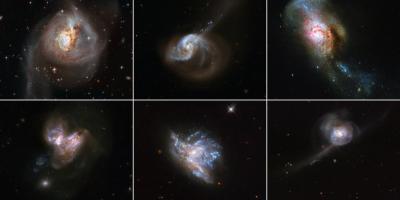
Credit: ESA/Hubble, NASA, the Hubble Heritage Team (STScI/AURA)-ESA/Hubble Collaboration and A. Evans (University of Virginia, Charlottesville/NRAO/Stony Brook University), A. Adamo et al.
It is during rare merging events that galaxies undergo dramatic changes in their appearance and in their stellar content. These systems are excellent laboratories to trace the formation of star clusters under extreme physical conditions.
The Milky Way typically forms star clusters with masses that are 10 thousand times the mass of our Sun. This doesn’t compare to the masses of the star clusters forming in colliding galaxies, which can reach millions of times the mass of our Sun.
These dense stellar systems are also very luminous. Even after the collision, when the resulting galactic system begins to fade into a more quiescent phase, these very massive star clusters will shine throughout their host galaxy, as long-lasting witnesses of past merging events.
By studying the six galaxy mergers shown here, the Hubble imaging Probe of Extreme Environments and Clusters (HiPEEC) survey has investigated how star clusters are affected during collisions by the rapid changes that drastically increase the rate at which new stars are formed in these galaxies. Hubble’s capabilities have made it possible to resolve large star-forming “knots” into numerous compact young star clusters. Hubble’s ultraviolet and near-infrared observations of these systems have been used to derive star cluster ages, masses, and extinctions and to analyse the star formation rate within these six merging galaxies. The HiPEEC study reveals that the star cluster populations undergo large and rapid variations in their properties, with the most massive clusters formed towards the end of the merger phase.
###
Each of the merging systems shown here has been previously published by Hubble, as early as 2008 and as recently as October 2020. To celebrate it’s 18th anniversary in 2008, the Hubble Space Telescope released a collection of 59 images of merging galaxies, which can be explored here: https:/
Media Contact
Bethany Downer
[email protected]
Original Source
https:/
Related Journal Article
http://dx.




